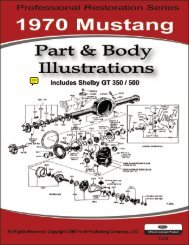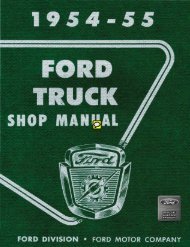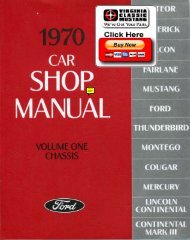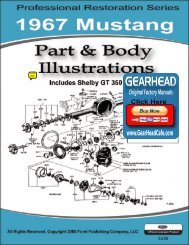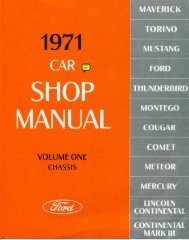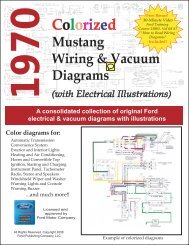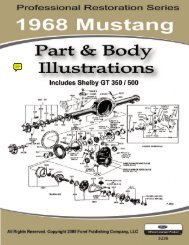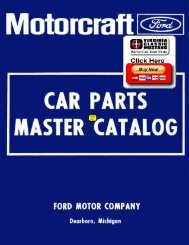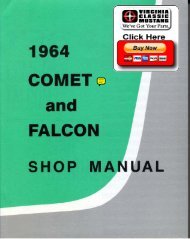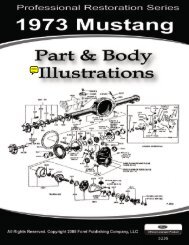DEMO - 1965 Ford Truck Shop Manual - ForelPublishing.com
DEMO - 1965 Ford Truck Shop Manual - ForelPublishing.com
DEMO - 1965 Ford Truck Shop Manual - ForelPublishing.com
You also want an ePaper? Increase the reach of your titles
YUMPU automatically turns print PDFs into web optimized ePapers that Google loves.
PART 2-7-AIR BRAKES 2-75<br />
PLUNGER<br />
RUBBER SPRING<br />
PISTON<br />
RETURN SPRING<br />
TO BRAKE<br />
CHAMBERS<br />
INLET SEAT<br />
RESERVOIR PRESSURE<br />
EXHAUST PORT<br />
FIG. 2—Foot Control Valve Operation<br />
the exhaust port. Further downward<br />
movement of the piston forces the<br />
inlet-exhaust valve from the inlet<br />
seat (Fig. 2) to open the passage between<br />
the reservoir pressure ports<br />
and the brake chamber ports.<br />
BALANCED POSITION. When<br />
the air pressure in the cavity beneath<br />
the piston and the air pressure being<br />
delivered to the brake chambers<br />
equals the mechanical force on top<br />
of the piston, the piston lifts and the<br />
inlet valve closes, cutting off any<br />
further flow of air from the reservoir<br />
pressure ports through the valve<br />
body. The exhaust Valve remains<br />
closed, however, because the mechanical<br />
pressure at the treadle holds<br />
the piston (seat) down against the<br />
valve. With both valves closed, no<br />
more air can enter and air already<br />
admitted can not escape. The valve<br />
is thus in a balanced position.<br />
If the treadle is depressed further,<br />
mechanical pressure over<strong>com</strong>es air<br />
pressure in the cavity beneath the<br />
piston opening the inlet valve again.<br />
This permits more reservoir air to<br />
enter until the pressure below the<br />
piston equals the mechanical pressure<br />
above and the inlet valve closes<br />
again. Complete depression of the<br />
treadle releases full reservoir pressure<br />
to the brake chambers.<br />
TO BRAKE<br />
CHAMBERS<br />
EXHAUST SEAT<br />
INLET EXHAUST<br />
VALVE<br />
RESERVOIR<br />
PRESSURE<br />
EXHAUST<br />
DIAPHRAGM<br />
HI 344-A<br />
RELEASED POSITION. If the<br />
treadle is partially released, air pressure<br />
beneath the piston over<strong>com</strong>es<br />
the mechanical pressure above, raising<br />
the piston and the inlet-exhaust<br />
valve assembly. This action closes<br />
the intake valve and opens the exhaust<br />
valve allowing air pressure<br />
from the brake chambers and lines<br />
to be released through the exhaust<br />
port. The air continues to exhaust<br />
until air pressure below the piston<br />
equals the mechanical pressure<br />
above. The foot control valve is<br />
again in balanced position. If the<br />
treadle is allowed to return to the<br />
fully released position, the exhaust<br />
valve remains open to exhaust all<br />
air from the chambers and fully release<br />
the brakes.<br />
Brake Chamber and Slack Adjuster.<br />
Compressed air, admitted to<br />
the brake chamber by the foot control<br />
valve, enters the chamber behind<br />
a diaphragm which forces the<br />
push rod outward (Fig. 12). The outward<br />
movement of the push rod rotates<br />
the slack adjuster which in turn<br />
rotates the brake camshaft and cam<br />
forcing the shoes against the drum.<br />
When the air pressure is released<br />
from the brake chamber, the brake<br />
shoe release springs and the brake<br />
chamber release springs return the<br />
FIG. 3-Hand Control Valve<br />
HIQOQ-A<br />
brake shoes, brake cam, slack adjuster,<br />
and the pushrod and diaphragm<br />
assembly to released position.<br />
Quick Release Valves and Relay<br />
Valve. The quick release valve (Fig.<br />
1) reduces the time required to release<br />
the brakes by hastening the<br />
exhaust of air from the brake chambers.<br />
The valve body contains a<br />
spring-loaded diaphragm so arranged<br />
as to permit supply pressure from<br />
the control valve to flow through<br />
the release valve to the brake chambers<br />
in one direction. When supply<br />
pressure is reduced, the air, which<br />
has passed through, is permitted to<br />
escape rapidly through the exhaust<br />
port.<br />
The quick release valve is used<br />
with both front and rear brake chambers,<br />
or with front chambers only as<br />
in the case of a T-Series truck.<br />
On a T-Series truck, the relay<br />
valve is used in place of the rear<br />
quick release valve (Fig. 20). The<br />
relay valve functions somewhat the<br />
same as the quick release valve, except<br />
that it services four rear brake<br />
chambers on a T-Series truck instead<br />
of two. The relay valve is also more<br />
sensitive to the action of the control<br />
valve in that it can assume a balanced<br />
position as well as apply and<br />
release.<br />
TRACTOR-TRAILER AIR BRAKE<br />
SYSTEM<br />
Tractor-trailer air brake equipment<br />
is available as a regular production<br />
option. The following items<br />
are included in the package.<br />
HAND CONTROL VALVE<br />
The hand operated brake application<br />
valve (Fig. 3) is mounted on the<br />
steering column. It controls the application<br />
of the trailer brakes independent<br />
of the tractor brakes.




